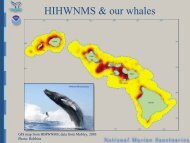The First International Conference on Marine Mammal Protected Areas
The First International Conference on Marine Mammal Protected Areas
The First International Conference on Marine Mammal Protected Areas
You also want an ePaper? Increase the reach of your titles
YUMPU automatically turns print PDFs into web optimized ePapers that Google loves.
MPAs in the Mediterranean and Black seas under ACCOBAMS, the CMS cetacean<br />
agreement.<br />
What is an MPA network? IUCN defines it as a system of individual MPAs operating<br />
cooperatively and synergistically, at various spatial scales, and with a range of protecti<strong>on</strong><br />
levels, in order to achieve ecological aims more effectively and comprehensively than<br />
individual sites could when functi<strong>on</strong>ing in isolati<strong>on</strong>. An MPA system should also c<strong>on</strong>fer<br />
social and ec<strong>on</strong>omic benefits, although the latter might <strong>on</strong>ly be fully realized over l<strong>on</strong>g<br />
time scales as ecosystems recover. With an MPA network, the whole is greater than the<br />
sum of its parts.<br />
<str<strong>on</strong>g>The</str<strong>on</strong>g> advantages of MMPA networks are that they can: (1) help compensate for the small<br />
sizes of most MMPAs, (2) protect linkages between various types of habitat and in doing<br />
so, support species, populati<strong>on</strong>s, and ecosystems, (3) bring together people and<br />
communities around a comm<strong>on</strong> interest in marine mammals and marine mammal<br />
habitat, (4) draw up<strong>on</strong> comm<strong>on</strong> legal frameworks to create shared or similar provisi<strong>on</strong>s<br />
for management, enforcement, research, and m<strong>on</strong>itoring, (5) help accommodate or adapt<br />
to the damaging effects of climate change, and (6) facilitate an ecosystem-based<br />
management approach, especially if this is employed in c<strong>on</strong>juncti<strong>on</strong> with ocean z<strong>on</strong>ing.<br />
<str<strong>on</strong>g>The</str<strong>on</strong>g> essential principles for designing and implementing MPA networks, as set down by<br />
the IUCN World Commissi<strong>on</strong> <strong>on</strong> <strong>Protected</strong> <strong>Areas</strong>, and all applicable to marine<br />
mammals, are: (1) include the full range of biodiversity present in the biogeographic<br />
regi<strong>on</strong>, (2) ensure that ecologically significant areas are incorporated, (3) maintain l<strong>on</strong>gterm<br />
protecti<strong>on</strong>, (4) ensure ecological linkages, and (5) ensuring maximum c<strong>on</strong>tributi<strong>on</strong>s<br />
of individual MPAs to the network.<br />
To create effective MMPAs and MMPA networks, we need to learn more about species,<br />
more about threats, and more about habitat. We need to characterize preferred habitat<br />
and identify where such habitat occurs using habitat preference models. We need to<br />
build human networks to collaborate <strong>on</strong> research projects covering whole oceans, such<br />
as the recent SPLASH project <strong>on</strong> humpback whales in the North Pacific. We need to<br />
have larger, more flexible, better-managed MPAs – 40% of all MMPAs are less than 100<br />
km 2 in size and many have no management plan. We need to think critically. For<br />
example, are MPAs always the answer? Ultimately, we may need to c<strong>on</strong>sider a much<br />
larger-scale approach and pay more attenti<strong>on</strong> to areas outside MPA borders and the<br />
spaces between parts of the MPA network. For this, the new tools of marine spatial<br />
planning and ocean z<strong>on</strong>ing could prove invaluable.<br />
<str<strong>on</strong>g>Internati<strong>on</strong>al</str<strong>on</strong>g>ly agreed targets (e.g., under the C<strong>on</strong>venti<strong>on</strong> <strong>on</strong> Biological Diversity) have<br />
provided the impetus to create many more MPA networks in nati<strong>on</strong>al waters and <strong>on</strong> the<br />
high seas by 2012. <strong>Marine</strong> mammal scientists have been charged with defining and<br />
describing critical habitat so that it can be included in MPA network proposals. We<br />
urgently need to fill the gaps in knowledge and to produce proposals that reflect the best<br />
science and incorporate a precauti<strong>on</strong>ary approach. Otherwise, new MPAs and MPA<br />
networks will be created without marine mammals in mind, and marine mammal habitat<br />
may be left largely out of the picture. <strong>Marine</strong> mammals have the potential to put MPA<br />
ICMMPA <str<strong>on</strong>g>C<strong>on</strong>ference</str<strong>on</strong>g> Proceedings<br />
2



